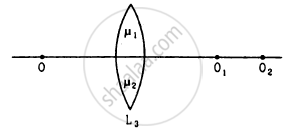Advertisements
Advertisements
प्रश्न
Consider three converging lenses L1, L2 and L3 having identical geometrical construction. The index of refraction of L1 and L2 are \[\mu_1 \text{ and } \mu_2\] respectively. The upper half of the lens L3 has a refractive index \[\mu_1\] and the lower half has \[\mu_2\] following figure . A point object O is imaged at O1 by the lens L1 and at O2 by the lens L2placed in same position. If L3 is placed at the same place,
(a) there will be an image at O1
(b) there will be an image at O2.
(c) the only image will form somewhere between O1 and O2
(d) the only image will form away from O2.
उत्तर
(a) there will be an image at O1
(b) there will be an image at O2
The lens L1 converges the light at point O1 and lens L2 converges the light at O2. As the upper half of lens L3 has a refractive index equal to that of L1, it will converge the light at O1 and thus the image will be formed at O1. Also, the lower half of lens L3 has a refractive index equal to that of lens L2, it will converge the light at O2 and thus the image will be formed at O2.
APPEARS IN
संबंधित प्रश्न
What is meant by a power of a lens? Define its SI unit.
How unit of power related to focal length of a lens?
What is the focal length of a convex lens of focal length 30 cm in contact with a concave lens of focal length 20 cm? Is the system a converging or a diverging lens? Ignore thickness of the lenses.
(a) At what distance should the lens be held from the figure in order to view the squares distinctly with the maximum possible magnifying power?
(b) What is the magnification in this case?
(c) Is the magnification equal to the magnifying power in this case? Explain.

What can you see in a completely dark room? If you switch on an electric bulb in this dark room as a light source, explain how you could now see:
(a) the electric bulb
(b) a piece of white paper
Consider two statements A and B given below:
A: real image is always inverted
B: virtual image is always erect
Out of these two statements:
What is the power of a convex lens lens whose focal length is 80 cm?
What is the nature of a lens whose power is, −4 D?
The optician's prescription for a spectacle lens is marked +0.5 D. What is the:
(a) nature of spectacle lens?
(b) focal length of spectacle lens?
Two lenses A and B have focal lengths of +20 cm and, −10 cm, respectively.
(a) What is the nature of lens A and lens B?
(b) What is the power of lens A and lens B?
(c) What is the power of combination if lenses A and B are held close together?
What is the unit of power of a lens? Define the unit of power of a lens.
How does focal length of a lens change when red light incident on it is replaced by violet light? Give reason for your answer.
Mohan obtained a sharp inverted image of a distant tree on the screen placed behind the lens. He then moved the screen and tried to look through the lens in the direction of the object. He would see:
(1) a blurred image on the wall of the laboratory.
(2) an erect image of the tree on the lens.
(3) no image as the screen has been removed
(4) an inverted image of the tree at the focus of the lens.
A convex lens produces a double size real image when an object is placed at a distance of 18 cm from it. Where should the object be placed to produce a triple size real image?
Consider the situation described in the previous problem. Where should a point source be placed on the principal axis so that the two images form at the same place?
What is meant by the power of accommodation produced?
The power of the magnifying glass depends on the distance of the magnifying glass from object.
Find the power of a convex lens of focal length of + 25 cm.
Define power of a lens. What is its unit? One student uses a lens of focal length 50 cm and another of –50 cm. What is the nature of the lens and its power used by each of them?
